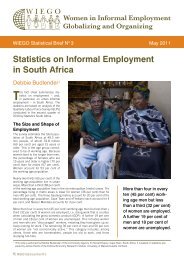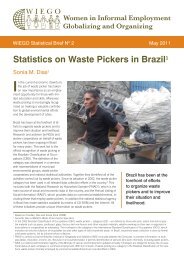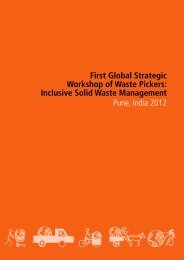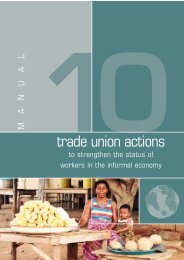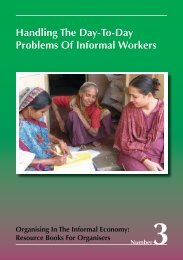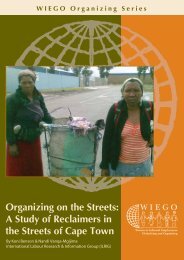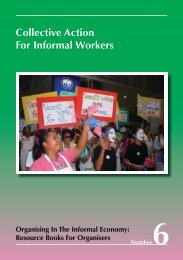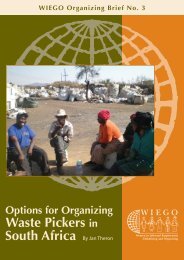Informal Economy Budget Analysis in Philippines and ... - WIEGO
Informal Economy Budget Analysis in Philippines and ... - WIEGO
Informal Economy Budget Analysis in Philippines and ... - WIEGO
You also want an ePaper? Increase the reach of your titles
YUMPU automatically turns print PDFs into web optimized ePapers that Google loves.
<strong>WIEGO</strong> Work<strong>in</strong>g Paper N o 12Millennium Development Goals (MDGs)The MDGs have been adopted by the Philipp<strong>in</strong>e government as a way to ensure brighter prospectsespecially for the Filip<strong>in</strong>o poor. The MDGs provide the framework <strong>in</strong> formulat<strong>in</strong>g the MTPDP’s socialcommitments <strong>and</strong> <strong>in</strong> identify<strong>in</strong>g programmes <strong>and</strong> projects <strong>in</strong> the MTPIP. The goals are to1) Eradicateextreme poverty <strong>and</strong> hunger; 2) Achieve universal primary education; 3) Promote gender equality <strong>and</strong>empower women; 4) Reduce child mortality; 5) Improve maternal health; 6) Combat HIV-AIDS, malaria <strong>and</strong>other diseases; 7) Ensure environmental stability; <strong>and</strong> 8) Develop a global partnership for development.MDG 1 is focused directly on the poor, <strong>in</strong>clud<strong>in</strong>g women <strong>and</strong> men <strong>in</strong> the <strong>in</strong>formal economy. SpecificMDG 1 targets are to: 1) Halve the proportion of women <strong>and</strong> men liv<strong>in</strong>g <strong>in</strong> extreme poverty between1990–2015; 2) Halve the proportion of women <strong>and</strong> men, girls <strong>and</strong> boys below the m<strong>in</strong>imum level of dietaryenergy consumption <strong>and</strong> halve the proportion of underweight children under five years; <strong>and</strong> 3) Halve theproportion of women <strong>and</strong> men without access to safe dr<strong>in</strong>k<strong>in</strong>g water <strong>and</strong> basic sanitation or those whocannot afford it by 2015.Kapit-Bisig Laban sa Kahirapan (KALAHI) or L<strong>in</strong>k<strong>in</strong>g Arms Aga<strong>in</strong>st PovertyKALAHI is the strategic framework <strong>and</strong> programme for poverty reduction under the Arroyo Adm<strong>in</strong>istration.The NAPC is the lead agency <strong>and</strong> houses the coord<strong>in</strong>at<strong>in</strong>g secretariat of the KALAHI programme. NAPCcounts a number of women among its sectoral representatives, <strong>in</strong>clud<strong>in</strong>g some belong<strong>in</strong>g to the urban poor<strong>and</strong> the <strong>in</strong>formal sector.To achieve the MDG goal of reduc<strong>in</strong>g extreme poverty <strong>and</strong> hunger, the government has been implement<strong>in</strong>gan <strong>in</strong>tegrated <strong>and</strong> comprehensive national poverty eradication strategy which focuses on asset reform,employment <strong>and</strong> livelihood, social protection <strong>and</strong> human development services.Asset reform is h<strong>in</strong>ged on the assumption that access to l<strong>and</strong> is one of the determ<strong>in</strong>ants of welfare <strong>in</strong> therural areas of the Philipp<strong>in</strong>es. Lack of access to l<strong>and</strong> not only limits the ability of the poor to engage <strong>in</strong>agriculture but also curtails their ability to <strong>in</strong>vest <strong>in</strong> human capital <strong>and</strong> productivity enhancements <strong>and</strong>to access f<strong>in</strong>ancial services. However, the Comprehensive Agrarian Reform Programme (CARP) will beimplemented only until June 30, 2009 if the Comprehensive Agrarian Reform Law (CARL) is not extendedby Congress. Sadly, most agrarian reform beneficiaries still have not received l<strong>and</strong> titles, support services,<strong>and</strong> key <strong>in</strong>frastructure support.In pursuit of the MDG target to improve the lives of slum dwellers, (number<strong>in</strong>g 675,000 families <strong>in</strong> 2004),the national government seeks to provide security of tenure to 300,000 households annually consist<strong>in</strong>g of:(a) 150,000 l<strong>and</strong> tenure units for the urban poor; (b) 70,000 social hous<strong>in</strong>g units for the urban poor; <strong>and</strong>(c) 80,000 low-cost hous<strong>in</strong>g units. S<strong>in</strong>ce the majority of the <strong>in</strong>formal workers are also slum dwellers, theyare supposed to benefit from the programme. For 2009, the hous<strong>in</strong>g sector budget <strong>in</strong>creased from PhP5.0billion to PhP5.3 billion which will be spent on the operational requirements of regulatory agencies; sett<strong>in</strong>gup resettlement sites <strong>and</strong> build<strong>in</strong>g new hous<strong>in</strong>g units; assist<strong>in</strong>g targeted beneficiaries <strong>in</strong> purchas<strong>in</strong>g lotsfrom their owners through the Community Mortgage Programme (CMP) <strong>and</strong> as equity for the payment ofmortgages for securitisation; <strong>and</strong> support<strong>in</strong>g a credit guarantee programme that provides risk cover <strong>and</strong>task <strong>in</strong>centives for hous<strong>in</strong>g credits extended by f<strong>in</strong>ancial <strong>in</strong>stitutions. But such a big budgetary allocation forhous<strong>in</strong>g may prove mean<strong>in</strong>gless to the poor <strong>in</strong> general, <strong>and</strong> for the <strong>in</strong>formal workers <strong>in</strong> particular, becausethe majority of them rarely avail themselves of government hous<strong>in</strong>g assistance programmes for reasons thatarise from lack of <strong>in</strong>formation, strong emphasis on mortgage f<strong>in</strong>ance, <strong>and</strong> rigid eligibility requirements.Employment <strong>and</strong> livelihood provisions for the poor: As a safety net for those who could possibly be laid off, thegovernment plans to accelerate spend<strong>in</strong>g for <strong>in</strong>frastructure <strong>and</strong> agriculture to generate employment. Hop<strong>in</strong>g toprime the economy, PhP229.6 billion or 16.2 percent of the PhP1.415 trillion national budgets will be allotted forpublic sector <strong>in</strong>frastructure <strong>in</strong> 2009. Accord<strong>in</strong>g to estimates of the Department of Public Works <strong>and</strong> Highways(DPWH), 30 percent of <strong>in</strong>frastructure outlay goes to the payment of labour. While the required <strong>in</strong>vestmentneeded to create one job is PhP100,000 approximately 540,000 new jobs are expected to be created.8




